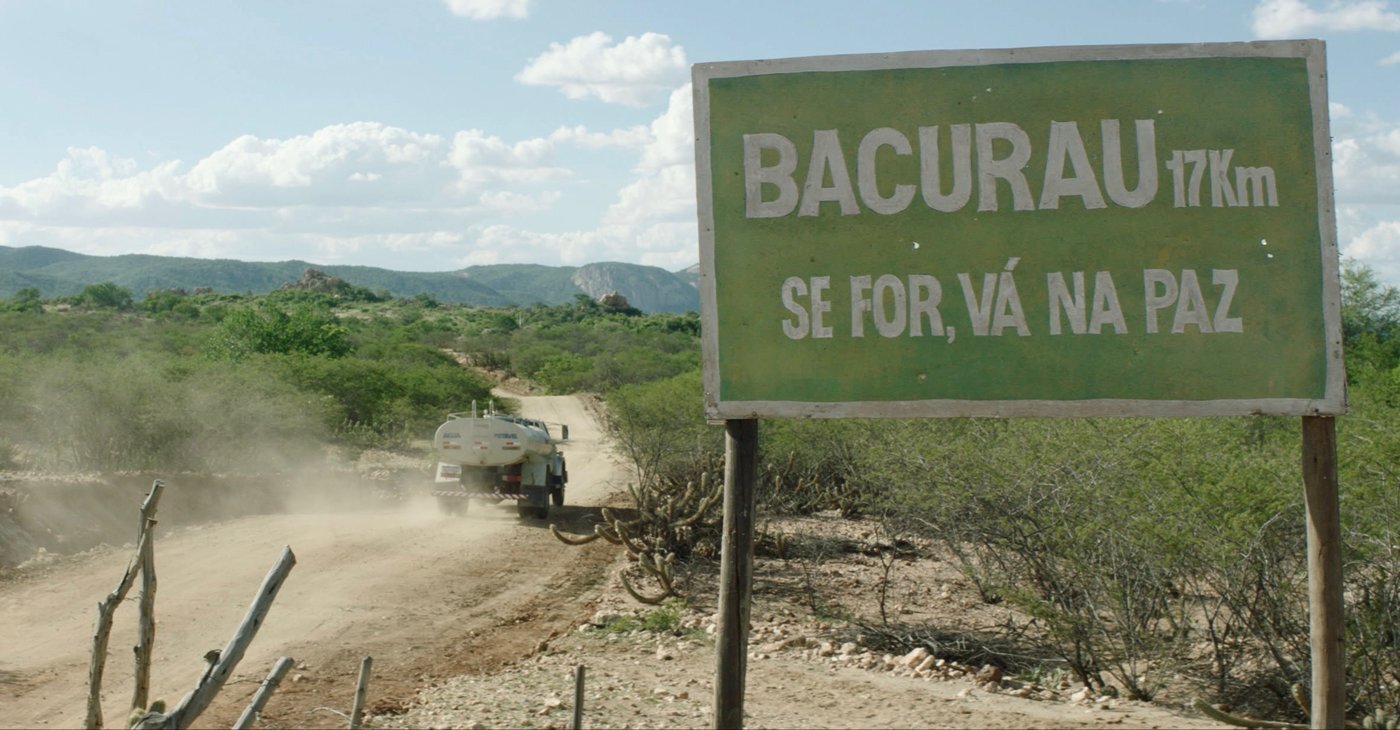Bacurau: A Community Fights Back
Bacurau, dir. by Juliano Dornelles and Kleber Mendonça Filho
Brazilian film Bacurau is a hallucinatory revenge drama that successfully marries Hollywood thriller, western and horror conventions to deliver a story about a town besieged by a group of foreign killers.
The film feels like an act of defiance against hard-right President Bolsonaro’s destruction of the Amazon, assault on indigenous communities and shocking mismanagement of the Covid-19 crisis. But it was ten years in development. And reflects much deeper-rooted problems of poverty, inequality and land ownership in Brazilian society.
At its heart, it’s a meditation on corruption, state violence and a political system not fit for purpose. As well as a warning about the lasting harm of colonialism and the pernicious role played by the United States in South America.
Released in 2019, it’s distinctive filmmaking of a kind that fills you with hope that we can reverse the current dystopian tide of history as the world faces multiple climate, ecological and economic crises.
When your back’s against the wall
Bacurau is set in a poor village in the Sertão, the impoverished northeast of Brazil. In a village whose water supply has been cut off by the corrupt regional mayor and his paid gunmen. The film opens with a tanker, bringing water to the village, encountering a load of coffins scattered across the road after a fatal accident between a truck and a motorcycle.
The viewer has been warned. Death is never far away in Bacurau!
The water tanker stops on a hill overlooking the dam. A ‘wanted’ image comes on the screen in the cab, promising a reward for turning in the bandit Lunga (played by Silvero Pereira), who had tried but failed earlier to restore the water supply.
Meanwhile, in the village, the inhabitants have gathered for the funeral of Carmelita, the elderly matriarch of the community.
As the narrative unfolds, everyone becomes increasingly unnerved by a sequence of strange events that follow the burial. The mobile phone signal goes down. The town disappears off Google Maps. UFO-shaped drones are sighted. Bullet holes appear in the side of the water truck. Horses stampede. Time-honoured cinematic signs that something terrible is about to happen.
We are introduced to a group of American, German and English gun-lovers based in a deserted house a few miles away from the village. They appear to have descended on the settlement with the express intention of killing the population for sport.
A local family are mysteriously murdered. A nine-year-old boy is slaughtered on the outskirts of the village. The villagers realise they are under attack and seek help from Lunga. He mobilises the villagers, arming them with old guns from the museum. A museum that also documents years of determined resistance against earlier oppressors.
In a violent battle, the villagers fight off and kill most of the foreigners. In a dramatic finale, Lunga cuts off the heads of the dead gunmen and lines them up outside the museum. And when the villagers clean up the splattered blood inside, they leave bloody handprints on the wall as a reminder of their defiance.
Only their leader Michael (played by the menacing Udo Kier) remains. But, captured by the villagers, he is buried alive in an underground cell beneath the main street while shouting that “this is only the beginning”. A pointed reminder of the impotence of power when faced by determined resistance.
The mayor, meanwhile, has been stripped naked, tied backwards to a donkey and packed off in humiliation.
Fight the power
Lunga is a fascinating figure. Gender-fluid, he dresses androgynously and sports gold rings, bracelets and eyeliner. He is also a former big-city gang member. And represents the physical embodiment of the village’s revenge, getting the bloodiest in the final battle.
The severed heads are a clear allusion to the cangaceiros. The bandits who thrived in the Sertão from the mid-19th century to the 1930s in direct response to the violent, unscrupulous landowners and political bosses who sought to exert their control over the region. Offering protection to the poorer sections of the population, the bandits constituted a direct threat to the authorities. On capture by the police, the cangaceiros would be decapitated and their severed heads left to decompose at the entrance to police stations.
The village museum even features a photograph of the head of Lampião, a famous bandit leader who became a folk hero, along with members of his gang after their ambush and shooting in 1938.
As historian Eric Hobsbawm noted in his classic study Bandits: “Banditry tended to become epidemic in times of pauperisation and economic crisis.” Rural societies were accustomed to periods of dearth caused by harvest failure and other natural crises. But deeper-seated social breakdown had the potential to lead to the emergence of bandit gangs, which might then evolve into genuine social movements. Becoming spearheads of resistance to the traditional order and symbols of the struggle for a better world.
This resistance is prefigured in an early scene in the film when the villagers perform the capoeira at the funeral of Carmelita. An Afro-Brazilian martial art, disguised as a dance, capoeira was developed by slaves in the 16th-century, and provided a focus for their fight for freedom and independence.
The dirge sung at the funeral gives the flavour of what is going to happen:
Now is the time for the bacurau the jaguar dances forward
the capoeira and babau dance/a feast of fear and terror
phantoms haunt the wake
punching holes in the trunk of night the woodpecker’s beak
spells are floating in the air
the work of an evil sorcerer
charms and jinxes dreamed up at the xang in Nicolau’s.
With echoes of spaghetti westerns, Lunga will become the village’s saviour, welding them together to fight the invaders.
What’s in a name?
Is there any significance in the title Bacurau? Unsurprisingly, yes.
It’s the name of a nocturnal bird, known in English as the nighthawk, mostly active at dusk and dawn as they hunt for insects. In other words, birds that use the passage from day and night to maximise their hunting chances. A metaphor for a marginalised community that must focus on their strengths – collective self-reliance and mutual support – to resist external violence and exploitation.
Predictably, the reaction of the Brazilian right to the film was universally hostile. But they were in a minority. The film has been a commercial success and was received with international acclaim.
It lifted the veil on the political and social divisions between the wealthier south and the poorer northeast of Brazil. And provided an acute study of Brazilian society, its social problems and the often violent contradictions that exist within it.
And, as co-director Kleber Mendonça Filho remarked in an interview, the village is based on an updated version of the quilombo – the settlements formed by escaped African slaves in 17th-century Brazil.
Bacurau offers a vision of a community where black, white, indigenous people; straight, gay and trans people; and farmers, teachers and bandits can happily co-exist, resist exploitation and fight oppression.
As the village motto puts it, Se for, vá na paz (If you go, go in peace).

